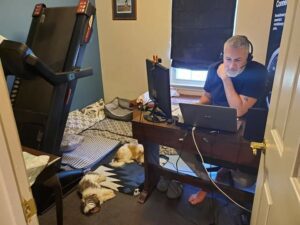Of the many lessons learned from the unprecedented change, challenges and disruption in the past year and a half, perhaps the most striking is the importance of a robust learning and development strategy that is well-aligned with business needs, especially when those needs change rapidly.
Many L&D organizations, including the 59 recognized as finalists in Chief Learning Officer’s 2021 LearningElite awards program, were already equipped with strong alignment to the business long before the COVID-19 pandemic. Those organizations, which were recognized at the annual LearningElite Gala on April 28, 2021, proved to be indispensable in the face of crisis.
At the head of the pack this year is multinational telecommunications giant Verizon.
The organization has built its learning strategy around supporting continuous and purposeful lifelong learning, says Lou Tedrick, vice president of global learning and development for Verizon, and it’s well-aligned to the business strategy and objectives of the company in several ways.
Verizon’s Global L&D team is part of the company’s broader HR organization. Their strategic planning process is closely tied to the business planning cycle, which allows them to see what specific skills and roles are critical for the next three to five years.
“We create an annual operating plan as an HR organization, then each of the organizations within HR build their plan,” Tedrick says.
On the bottom line
Verizon’s learning strategy has had a significantly positive impact on the company’s bottom line, even during a pandemic.
In fact, this past year during COVID-19, the company launched numerous promotions to support customers during the pandemic — all launches supported by the Global L&D team, and in a time when “it’s really important to stay connected,” Tedrick says.
The Global L&D team served a critical role in the company’s efforts to establish touchless retail operations to function during the pandemic. Retail representatives, store managers and district managers all needed to be educated on how to set up their stores, implement social distancing and employ touchless technology.

“When we do work with a business, we typically try to identify the business problem that we’re trying to solve for,” Tedrick says. “Do we have metrics that we could look at to see if they shift? Those are their indicators that there’s a problem. We will do our studies along the way to make sure that those metrics are moving in the right direction.”
Measurement of strategy
The Global L&D team evaluates all their initiatives for learning solution effectiveness by applying the Phillips/Kirkpatrick model methodology. These evaluations are typically done in the form of assessments or demonstrations that are observed by the business leaders or someone from the Global L&D team. To review business impact, Tedrick says they work with business leaders to evaluate whether there was a measurable improvement or change and how much of that can be attributed to the applied learning solution.
To measure the impact of some of the less programmatic or “hard science” related areas, such as the organization’s culture transformation initiatives, Tedrick says they launch employee surveys, from which they review all metrics to see how things are moving based on learning interventions they have applied with groups or across the business.
“Not only do we have what I would consider the hard science, when you’re working with a call center or a retail store, [but] also on some of these more soft skills or longer-term skills like leadership development, we’ll look for other indicators through the business to see, are we really effective in helping move the business forward?” she says.
Pandemic challenges
In early 2020, companies quickly transitioned en masse from working in an office to working as a fully or nearly fully remote workforce. The good news for Verizon was they already had the technical infrastructure to support their workers, including at-home programs for their call centers, virtual instructor training for their trainers and training for their instructional designers on how to create programs for virtual instruction.
They were able to quickly skill up their team to convert everything, including the most critical areas, such as new hire curriculums and new employee orientation, as well as new leadership curriculum, as they were still bringing new leaders into the business. “This all happened within the first two to three weeks,” Tedrick says.
By the end of the first 60 to 90 days, the company’s entire curriculum was fully virtual. This cleared the pathway for the organization to hone in on what was critical to business success during the pandemic.

When COVID became significant, like other retailers, Verizon closed many of its stores temporarily, Tedrick says. “We had this highly skilled retail workforce without a place to use their skills. Simultaneously, we saw that our customers, rather than going into retail stores, began to call customer services and our opportunity with telesales grew. So to help manage the shift in customer behavior and leverage the skills of our retail workforce, we implemented a retail reskilling initiative.”
The Global L&D team built curriculums for retail representatives to reskill them for temporary roles in customer service, telesales, conferencing and other areas where there was an opportunity to increase customer support.
“What was really exciting was that it wasn’t multiple weeks of training, it was two, three days — very surgical,” Tedrick says. “When we’d talk to reps, or when they would talk to our leaders, they would say, ‘I really appreciated that people respected what I knew and what I brought to the table — and only spent time training me on all the essentials, so that I could be successful.’ It was a huge win for our employees and for our customers.”
Also during the pandemic, they were able to create new learning pathways on remote work environments and how to effectively work and communicate in a virtual setting. Overall, a lot was learned in a short amount of time, Tedrick says.
“As I talk to my peers, we’ve all learned a lot about things in our organizations that we thought were essential that we were able to cut out, and nothing went wrong,” she says.
The road ahead
As Verizon plans for what lies ahead, Tedrick says they are thinking about what they’ve learned and what they want to take with them into the future.
“Because there’s so much that we learned, even if we are in a blended situation with learning, there are things that we just won’t need to train anymore because we know we can use the performance support to deliver people what they need,” she says.
The company is also doing strategic workforce planning to identify critical skills and roles for the Global L&D team to explore.
“I think we’re really strong at execution,” Tedrick says. “We have a full array of resources, capabilities and know-how. We proved, this year, that if you give us just a little bit of time to think about it, we can quickly pivot and adjust.”















